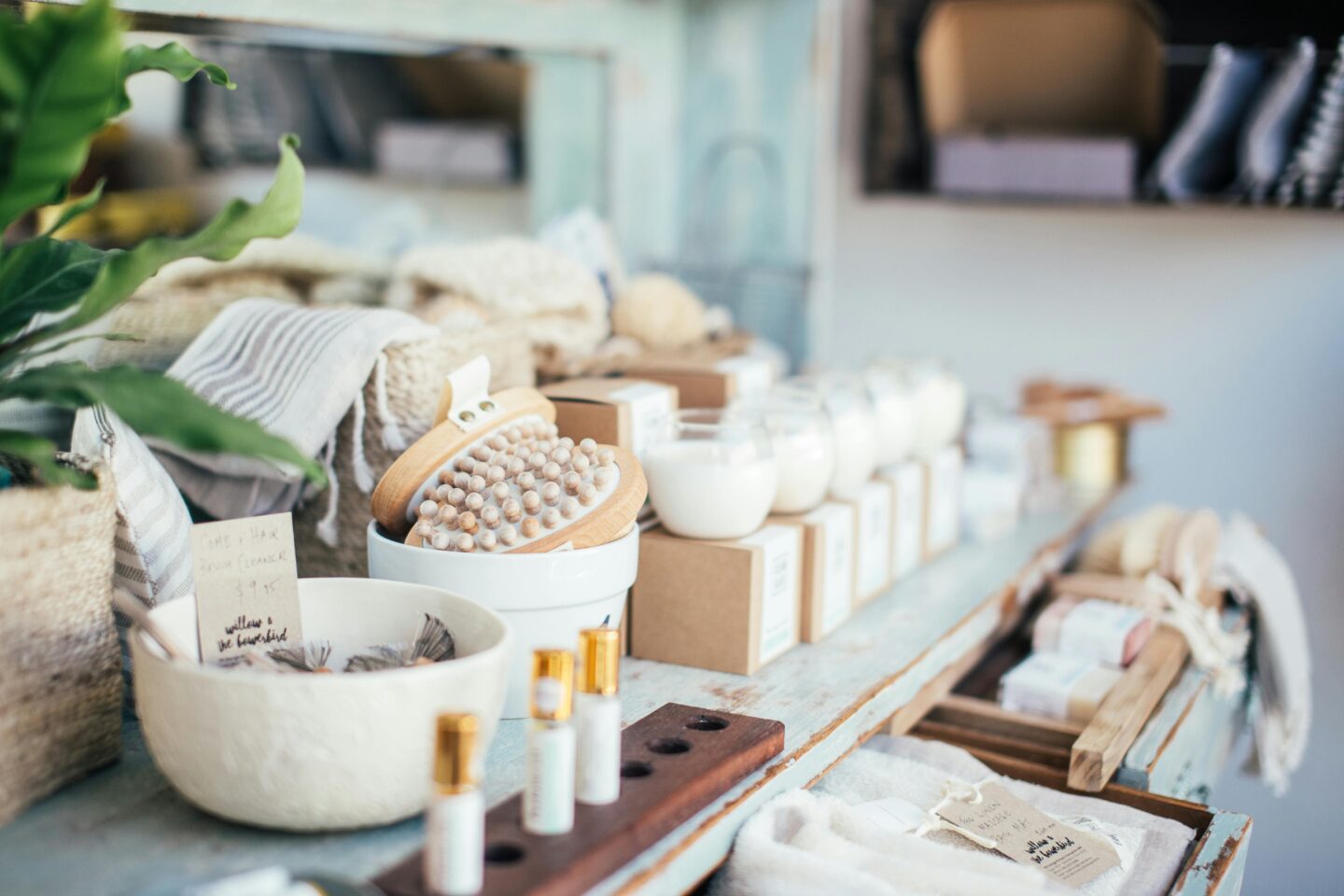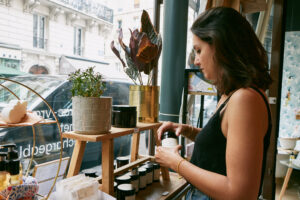

Develop your shop
Optimise your point of sale

How to organise your beauty store: the ultimate guide for an unforgettable customer experience
18 July 2024
Designing a beauty store requires thoughtful planning and creativity. In this article, we guide you through eight essential steps to create an attractive yet functional space that ensures a memorable customer experience.
 Alrie Velleman
Alrie Velleman
1. Integrating concept, brand image, and design in your beauty store
a. The importance of visual identity
Your company’s visual identity is the first impression customers will have of your cosmetics and beauty store. It must consistently reflect your concept across all customer touchpoints. Convey your brand values clearly—whether they are vegan, organic, made locally, or others—so customers can quickly understand and identify with your brand, encouraging them to enter your shop.
b. Aligning brand values with store design
The layout and design of your shop must also be perfectly in line with your values and your concept. For example, if you advocate eco-responsibility, opt for furniture made from sustainable and recycled materials. If you’re focused on locally produced products, showcase decorative items made by local craftspeople. This holistic approach will enable you to create a memorable customer experience and stand out in a competitive market.

Looking for the next bestsellers for your beauty shop?
Discover
You can divide your beauty store into three main areas to optimise the customer experience:
- The entrance area: this is your “hotspot”. Use this area to present your new products or seasonal items. Keep it uncluttered and welcoming so as not to overwhelm customers as soon as they arrive.
- The central area: the ideal place for your staple products and your most popular ranges. Organise them thematically (face care, body care, hair care, etc.) to make it easier to browse and find products.
- The back of your shop: Place your most sought-after items (think of the products your customers are specifically looking for) and special offers here. This will draw customers through the entire shop, increasing the likelihood of impulse purchases along the way. 🤞
To optimise your customer journey through your store, you have to create a clear and intuitive path. Avoid narrow or crowded aisles and leave enough space for customers to move around comfortably, even during busy periods.
Remember to consider safety and accessibility standards when designing your store layout.
The presentation of your cosmetics is crucial to attracting customers’ attention and encouraging them to buy. Here are a few tried-and-tested techniques to keep in mind:
- 👀 Eye zone: place your star products and new releases at eye level. Naturally, this is the area where attention will be focussed immediately.
- 🫳 Hand zone: just below, create an easily accessible zone for products that customers like to touch and test. Ideal for creams, serums or perfume samples.
- ⬇️ Bottom zone: reserve this zone for bulkier products like big shampoo containers.
Choosing the perfect display units for your store is essential for showcasing your cosmetic products:
- Open displays: products you want to showcase, like your bestsellers or new brands or ranges.
- Closed displays: more delicate or top-of-the-range products that might need higher protection.
- Themed displays: create dedicated areas by type of skincare product (face, body, hair) or by brand to make it easier for your customers to navigate.
- Roller counter: a versatile element that can be used to create temporary or seasonal displays, ideal for promotions or new product launches.
Tell a story with your displays!
- Create seasonal or themed displays (for example, a “summer holiday” atmosphere for suncare and bronzing products ☀️).
- Use decorative elements to highlight key ingredients in your products (for example, sprigs of lavender for a range with lavender essential oil).
- Incorporate visual and textural elements that tell the story of your brand or products.
Encourage interaction with products by creating dedicated test areas such as open displays. Where possible, testers for each product should also be offered. Remember to keep these clearly labelled and easily accessible.
By thoughtfully organising your cosmetics shop into dedicated areas and using effective presentation techniques, you can create an inviting and engaging shopping experience.
A make-up corner can become the highlight of your shop. Install well-lit mirrors and comfortable seating to allow customers to try products, and provide disposable make-up tools for hygiene. This could be the perfect spot for qualified sales staff to offer customers live demonstrations, boosting both customer engagement and sales.
An area dedicated to personalised advice is an excellent way to enhance your customer experience. You’ll need to train your staff to offer advice based on each customer’s specific needs and, of course in-depth product knowledge. You can also use this area to offer mini-workshops or product demonstrations.
The shop window is customers’ first impression of your beauty store. It’s your best tool for attracting attention and enticing passers-by to come in. Here are our top tips for this crucial space.
- Place your flagship products (new products and bestsellers) at eye level.
- Use one of the four effective layout models (symmetrical, semi-symmetrical, repetitive, alternating).
- Use lighting to highlight key products, draw attention to featured items, and create an inviting atmosphere.
- Use signage, products and decoration to communicate your brand’s history and values.
- Create themed displays that align with collections or seasonality.
Find all our advice on visual merchandising here.
Keep customers interested by updating your display at least once a month. Coordinate these changes with product launches, seasons, or special events by creating an editorial calendar to plan themed displays in advance.
Ensure the checkout counter complements your shop’s overall aesthetic. It should offer ample space for customers to comfortably place their purchases. Additionally, prioritise ergonomic considerations for your employees by providing a comfortable workspace, whether they are sitting or standing.
Capitalise on customer traffic at the checkout to drive impulse purchases. Install displays on the counter featuring low-priced products or special offers like “buy 2, get 1 free”. Consider stocking small items such as lip balms, hand creams, or travel-sized products to tempt customers with convenient, last-minute buys.
Lighting is pivotal in shaping the atmosphere of your shop and effectively presenting your products. Warm lighting that evokes comfort and cosiness is ideal for showcasing skincare products. Alternatively, cooler and brighter lighting can accentuate make-up products, emphasising their colours and textures.
In addition, employ directional spotlights strategically to highlight specific products, creating focal points that draw customer attention and enhance visual appeal throughout your entire shop.
Incorporate music as another element that contributes to your store’s multi-sensory experience. You can craft a playlist to match the atmosphere you want to create. Be careful to adjust the volume so that it’s pleasant without being intrusive.
Select the perfect room fragrance to enhance the overall sensory experience for customers. We recommend using subtle diffusers that complement your products rather than overpowering them.
Implementing an omnichannel sales strategy can significantly benefit your business if you have both an online shop and a physical store. Here’s how you can integrate omnichannel shopping principles into your operations:
Ensure consistency in your visual identity across your website and physical shop. Use consistent colours, fonts in your communications, and maintain the same logo. This ensures customers who are familiar with your website can immediately recognize your brand image when they visit your shop, and vice versa. This unified approach reinforces your brand identity and enhances brand recognition across all customer touchpoints.
Use QR codes on displays that link back to your online site, where your customers can find detailed product information, tutorials, ideas for complementary products, etc.
If you offer a click-and-collect service to your customers, dedicate space with clear signage and make the collection process as easy as possible.










